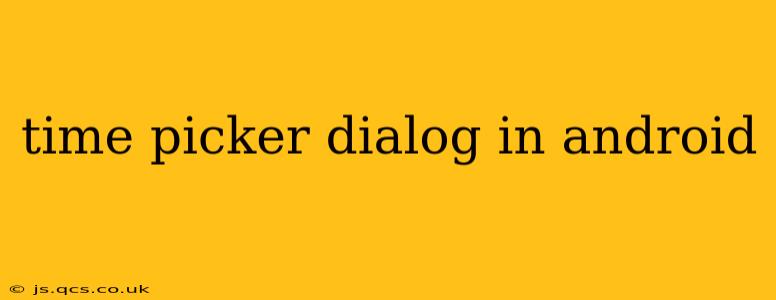Android's time picker dialog provides a user-friendly interface for selecting a time. This guide covers everything from basic implementation to advanced customization, ensuring you can seamlessly integrate this crucial component into your Android applications. We'll explore different approaches, handle potential issues, and offer best practices for a smooth user experience.
What is a Time Picker Dialog?
The TimePickerDialog is a pre-built Android component that presents a dialog box allowing users to select a time (hour and minute). It's a convenient way to avoid building a custom time selection interface, saving you development time and ensuring consistency with the Android design language. This dialog simplifies the process of obtaining time inputs from users within your applications.
How to Implement a Simple Time Picker Dialog
The simplest way to implement a TimePickerDialog involves using the TimePickerDialog class directly. Here's a code snippet demonstrating this:
TimePickerDialog timePickerDialog = new TimePickerDialog(this,
(view, hourOfDay, minute) -> {
// Do something with the selected time
String time = hourOfDay + ":" + minute;
// Update UI or perform other actions with the selected time.
},
Calendar.getInstance().get(Calendar.HOUR_OF_DAY),
Calendar.getInstance().get(Calendar.MINUTE),
true); //is24HourView
timePickerDialog.show();
This code creates a TimePickerDialog that uses the current time as the default. The lambda expression handles the time selection, allowing you to process the selected hourOfDay and minute. Remember to replace the comment with your desired actions. The true parameter sets the dialog to 24-hour format; set it to false for AM/PM format.
Customizing the Time Picker Dialog
While the basic implementation is straightforward, you can customize the TimePickerDialog to better fit your app's design and functionality.
Styling the Dialog
While direct styling options are limited, you can influence the appearance indirectly:
- Theme: Applying a custom theme to your entire app will affect the TimePickerDialog's appearance.
- Context: The context provided to the
TimePickerDialogconstructor can influence its style.
Setting a Different Time as Default
You can set a custom default time using the Calendar class:
Calendar calendar = Calendar.getInstance();
calendar.set(Calendar.HOUR_OF_DAY, 14); // Set default hour to 2 PM
calendar.set(Calendar.MINUTE, 30); // Set default minute to 30
TimePickerDialog timePickerDialog = new TimePickerDialog(this,
(view, hourOfDay, minute) -> { /* ... */ },
calendar.get(Calendar.HOUR_OF_DAY),
calendar.get(Calendar.MINUTE),
true);
timePickerDialog.show();
Handling AM/PM Format
The is24HourView boolean parameter in the TimePickerDialog constructor controls whether to display the time in 24-hour or AM/PM format.
How to Display the Selected Time in the UI
After the user selects a time, you'll typically want to display it in your app's UI. This usually involves updating a TextView or similar UI element:
TextView selectedTimeTextView = findViewById(R.id.selectedTimeTextView);
TimePickerDialog timePickerDialog = new TimePickerDialog(this,
(view, hourOfDay, minute) -> {
String time = String.format("%02d:%02d", hourOfDay, minute); // Format to 00:00
selectedTimeTextView.setText("Selected Time: " + time);
},
Calendar.getInstance().get(Calendar.HOUR_OF_DAY),
Calendar.getInstance().get(Calendar.MINUTE),
true);
timePickerDialog.show();
This code updates the selectedTimeTextView with the formatted time.
Using TimePicker in a Fragment
Implementing a TimePickerDialog within a Fragment is very similar to using it in an Activity:
TimePickerDialog timePickerDialog = new TimePickerDialog(requireContext(),
(view, hourOfDay, minute) -> {
// Handle the selected time
},
Calendar.getInstance().get(Calendar.HOUR_OF_DAY),
Calendar.getInstance().get(Calendar.MINUTE),
true);
timePickerDialog.show();
Remember to replace requireContext() with the appropriate context if needed.
Troubleshooting Common Issues
- NullPointerException: This often occurs due to incorrect context or view initialization. Ensure all views are correctly inflated before accessing them.
- Incorrect Time Format: Carefully format the time string to match your desired output.
This comprehensive guide covers the essential aspects of using the TimePickerDialog in Android. Remember to adapt these code snippets to your specific application needs and context. By understanding the fundamental concepts and common customization options, you can effectively integrate time selection functionality into your Android applications.
